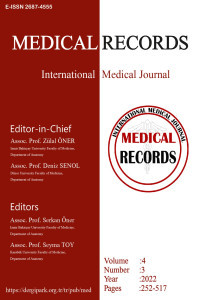Determining the Relationship Between Compassion Fatigue and Job Satisfaction and Burnout Levels in Physiotherapists
Determining the Relationship Between Compassion Fatigue and Job Satisfaction and Burnout Levels in Physiotherapists
Burnout, Compassion fatigue Job satisfaction, Physiotherapist,
___
- Türk Dil Kurumu, https://sozluk.gov.tr/ access date: 18.06.2023.
- Meyer RM, Li A, Klaristenfeld J, Gold JI. Pediatric novice nurses: examining compassion fatigue as a mediator between stress exposure and compassion satisfaction, burnout, and job satisfaction. J Pediatr Nurs. 2015;30:174-83.
- Cingi CC, Eroğlu E. Sağlık çalışanlarında merhamet yorgunluğu. Osmangazi Tıp Dergisi. 2019;41:58-71.
- Çinarli T. Factors affecting compassion fatigue in emergency nurses. PhD Thesis, Ondokuz Mayıs University, Samsun, 2019.
- Pehlivan T. The Effect of the short-term and long-term compassion fatigue resiliency program on the quality of life, perceived stress and psychological resilience of oncology-hematology nurses. PhD Thesis, Koç University, İstanbul, 2019.
- EA P. The compassion scale. Dissertation Abstracts International Section A: Humanities and Social Sciences 2011;72:1174.
- Akdeniz S, Deniz M. The Turkish adaptation of compassion scale: the validity and reliability study. The Journal of Happiness & Well-Being. 2016;4:50-61.
- Hackman JR, Oldham GR. Development of the job diagnostics survey. Joumal of Applied Psychology. 1975;60:159-70.
- Güler M. Endüstri işçilerinin iş doyumu ve iş verimine depresyon, kaygı ve diğer bazı değişkenlerin etkisi. PhD thesis, Hacettepe University, Ankara, 1990.
- Maslach C, Jackson SE. The measurement of experienced burnout. Journal of Organizational Behavior. 1981;2:99-113.
- Ergin C. Doktor ve hemsirelerde tukenmislik ve Maslach tukenmislik olceginin uyarlanmasi. VII Ulusal Psikoloji Kongresi, 22th September 1992. Ankara, Türkiye
- Kişmir Ş, İrge NT. The impact of compassion fatigue on employees motivation and job satisfaction: an application on non-physician healthcare workers and a public-private hospital comparison. R&S-Research Studies Anatolia Journal. 2020;3:1-18.
- Strauss C, Taylor BL, Gu J, Kuyken W, Baer R, Jones F, et al. What is compassion and how can we measure it? A review of definitions and measures. Clin Psychol Rev. 2016;47:15-27.
- Blomberg K, Griffiths P, Wengström Y, et al. Interventions for compassionate nursing care: a systematic review. International journal of nursing studies. 2016;62:137-55. Erratum in: Int J Nurs Stud. 2018;83:104-5.
- Agho AO, Mueller CW, Price JL. Determinants of employee job satisfaction: an empirical test of a causal model. Human Relations. 1993;46:1007-27.
- Kök SB. Iş tatmini ve örgütsel bağlılığın incelenmesine yönelik bir araştırma. Atatürk Üniversitesi İktisadi ve İdari Bilimler Dergisi. 2006;20:291-317.
- Üstünbaş G. Türkiye’de fizyoterapistlerde tükenmişlik, iş doyumu ve yaşam kalitesi düzeylerinin araştırılması. Master's Thesis, Abant İzzet Baysal University, Bolu, 2011.
- Sorenson C, Bolick B, Wright K, Hamilton R. Understanding compassion fatigue in healthcare providers: a review of current literature. J Nurs Scholarsh. 2016;48:456-65.
- Ashtari Z, Farhady Y, Khodaee MR. Relationship between job burnout and work performance in a sample of Iranian mental health staff. Afr J Psychiatry (Johannesbg). 2009;12:71-4.
- Sünter AT, Canbaz S, Dabak Ş, et al. Pratisyen hekimlerde tükenmişlik, işe bağlı gerginlik ve iş doyumu düzeyleri. Genel Tıp Dergisi. 2006;16:9-14.
- Ozyurt A, Hayran O, Sur H. Predictors of burnout and job satisfaction among Turkish physicians. QJM. 2006;99:161-9.
- Ebrinç S, AÇIKEL C, Başoğlu C, et al. Yanık merkezi hemşirelerinde anksiyete, depresyon, iş doyumu, tükenme ve stresle başa çıkma: Karşılaştırmalı bir çalışma. Anadolu Psikiyatri Dergisi. 2002;3:162-8.
- Erbil N, Bostan Ö. Ebe ve hemşirelerde iş doyumu, benlik saygisi ve etkileyen faktörler. Anadolu Hemşirelik ve Sağlık Bilimleri Dergisi. 2010;7:56-66.
- Ünal S, Karlıdağ R, Yoloğlu S. Hekimlerde tükenmişlik ve iş doyumu düzeylerinin yaşam doyumu düzeyleri ile ilişkisi. Klinik Psikiyatri. 2001;4:113-8.
- Fatma Nur Polat Re. The relationship between the level of compassion fatigue and quality of professional life: the case of medical professionals. Journal of Süleyman Demirel University Institute of Social Sciences. 2017;1:291-312.
- Yayın Aralığı: Yılda 3 Sayı
- Başlangıç: 2019
- Yayıncı: Zülal ÖNER
The Importance of Perinatal Care Practices in Determining Pregnant Women's Satisfaction with Birth
Ece ÖCAL, Senem ALKAN AKALIN, Serap Mutlu ÖZÇELİK OTCU
Five-Years Intensive Care Percutaneous Tracheostomy Results
Kubilay İŞSEVER, Ali MUHTAROĞLU, Furkan Ali UYGUR, Muhammet Burak KAMBUROGLU
Tuba EKMEKYAPAR, Seval DEMİR AYDIN
The Consequences of Fasting During Pregnancy on the Thiole/Disulfide Balance: An Observational Study
Senem ALKAN AKALIN, Ece ÖCAL, Serap Mutlu ÖZÇELİK OTCU
Effects of Electromagnetic Field (1.8/0.9 GHz) Exposure on Spleen in Rats
İlker KIZILOĞLU, Yeliz YILMAZ BOZOK, Levent TÜMKAYA, Dilek AKAKIN, Dila ŞENER AKÇORA
Role of SARS-CoV2 Virus in the Etiology of Acute Pancreatitis
İlker KIZILOĞLU, Didem DERELİ AKDENİZ, Funda UĞUR KANTAR
Retrospective Assessment of Forensic Facts Under 18 Years of Age in İzmir
Ferhat Turgut TUNÇEZ, Ece ERGÜN YEGEN, Derya GÜLMEZ ÖZ, Doğu Barış KILIÇÇIOĞLU
